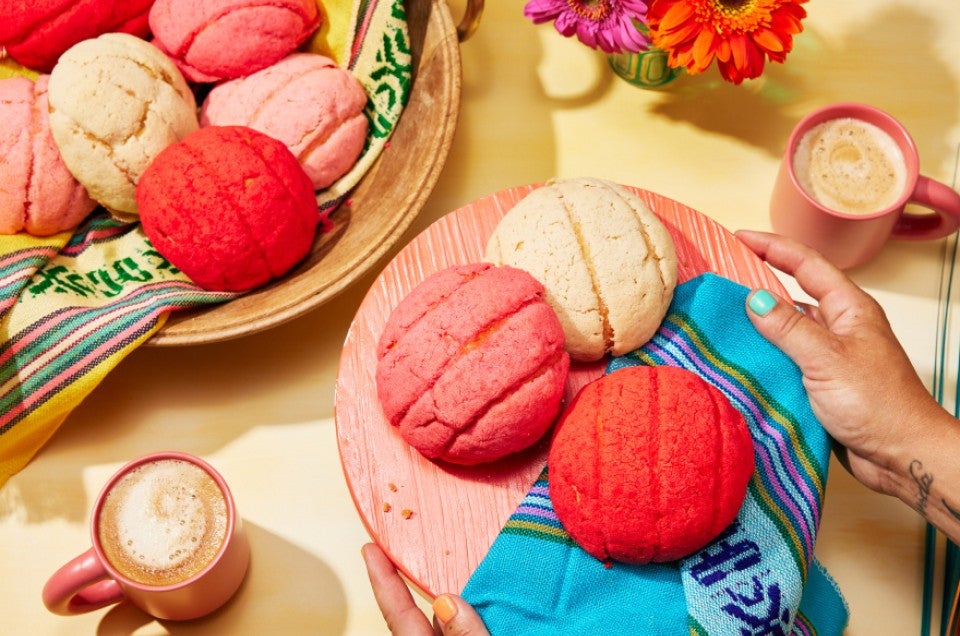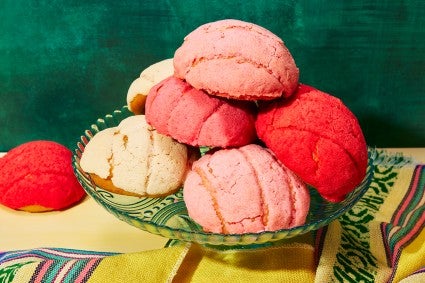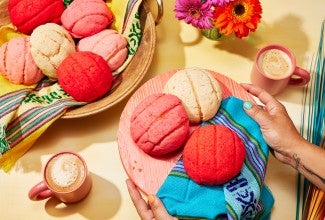Conchas are a colorful, creative canvas
Bakers are using colorful designs and innovative scoring to make new versions of a classic Mexican pastry.


This article is part of our feature celebrating Pan Dulce. Find all things pan dulce here.
When Agueda Ulloa recently opened her mobile bakery, Café Olla, after several years of primarily selling pan dulce out of her home, she knew she wanted to bake something celebratory to commemorate the occasion. The answer, naturally, was conchas; the sweet buns, with their crackly topping, are the perfect canvas for innovation. In the spirit of celebration, Agueda whipped up a batch of Funfetti conchas, the signature cookie-shell topping speckled with rainbow sprinkles.
“I wanted something playful and vibrant,” recalls Agueda, who bakes in Alameda, California. What better solution than transforming her signature conchas into a cake-inspired confection?
Agueda isn’t the only baker who embraces the possibilities of conchas. Across the country, Mexican and Central American bakers are using the beloved pan dulce as a jumping-off point for experimentation.
Teresa Finney of Atlanta’s At Heart Panadería innovates her conchas with flavor iterations like strawberry sumac and berry pink peppercorn, coloring them using “lots of freeze-dried fruit.” She also points to bakers experimenting with scoring: “I’ve seen spiral scoring and even some scoring using cookie cutters like heart and star shapes.”
One such baker is Mayra Sibrian of Selva Central Goods in Seattle, whose pastel palette of conchas all feature a rustic spiral design, instead of the pan dulce’s namesake shell-like pattern, to “set my conchas apart,” she says. Like Teresa, Mayra also brightens up her conchas with seasonal flavors and colors, like her recent purple passionfruit and blackberry concha.
There are hot pink conchas, like the ones Roxanne Sanchez makes at Delicias Bakery & Some in Highland Park, California; Hello Kitty conchas, from Gloria Ruiz (@yoyiesweets) in Los Angeles; and tie-dyed conchas, as Esteban Castillo of Chicano Eats demonstrates. And that just scratches the surface.
These bakers are taking the traditional concha — an old panadería standby typically relegated to just vanilla, chocolate, and strawberry flavors — and transforming it into new expressions of flavor and color. The concha doesn’t have to be classic. For today’s bakers, it can be anything they want it to be.
Start with a solid recipe, like our Conchas, then follow the tips below from expert bakers to color the topping and make your own creative iterations.
Many bakers recommend using ground freeze-dried fruit to color the topping, which adds subtle flavor and pastel color, and won’t change the consistency of the cookie dough topping. “I usually stick to strawberry, raspberry, and blueberry,” recommends Teresa. “If you add freeze-dried fruit, make sure you grind it down to a powder,” recommends Mayra. “A spice or coffee grinder works best.” If you’re baking our recipe for Conchas, our Test Kitchen recommends 1/4 cup (10 grams) of powdered freeze-dried fruit mixed into the topping.
“Hibiscus petals processed down to a powder is another fun one because it doesn’t really lose its magenta color during the bake, which can happen with freeze-dried fruit,” Teresa notes. She prefers fruit powders and other natural inclusions because of the flavor they add to conchas, unlike flavorless food dyes. She adds, “I really go heavy-handed with the powdery inclusions because I want the color to stand up to the heat of the bake.”
Roxanne likes to add a little beet juice to her electric pink conchas, which she also colors with freeze-dried strawberries, to give them an extra color boost. Her other favorite coloring options include matcha powder, turmeric, moringa powder, and ground lavender petals.
If you’re using natural food colorings or ingredients, “I recommend aiming for pastels or lighter colors, because once you bake the conchas, the color browns and fades a little bit,” says Agueda.
Mayra acknowledges that freeze-dried fruit doesn’t always get the job done: “As a last resort, I’ll use natural food coloring found in most natural health stores.” Supernatural Food Colors are our preferred brand at King Arthur for their saturated color, which remains even after baking.
If you want vibrant, electric color, Esteban recommends gel food coloring instead. “I’ve tried using natural materials in the past, but they don’t give off the vibrant payoff I’m looking for, and some materials tend to dull after baking,” he says. An added bonus is that concentrated gel coloring won’t mess with the hydration of the topping, unlike liquid food coloring.
Whether you’re using natural food dyes or gel coloring, mix in a little bit of food coloring to the topping dough to start, then continue adding bit by bit until you achieve your desired hue.

“The topping is a great place to let your imagination run wild and play around with color,” says Mayra. Don’t limit yourself to just one color. “You can make pastes of different pigmentations and incorporate them into one concha for a beautiful color bomb.” Tie-dye or ombre effects or designs like flowers and polka dots are a fun way to customize each concha with color.
Or take a cue from Roxanne and go beyond just coloring the topping: “I’m working on a bougainvillea concha, with flowers pressed into the topping.”
Ultimately, “the possibilities are endless,” encourages Agueda.
Watch pastry chef Fany Gerson show you how to make conchas, including a black and white version, in our video:
Cover photo by Rick Holbrook; food styling by Kaitlin Wayne.


